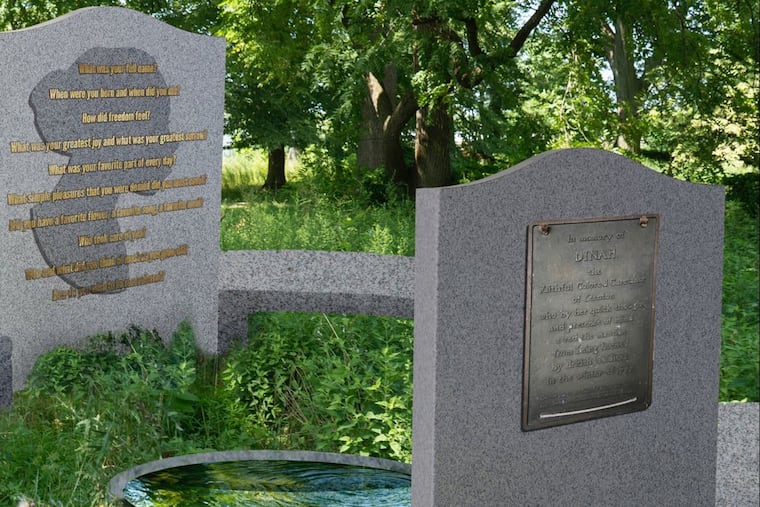You can vote on artists’ proposals to memorialize Dinah, the once-enslaved woman known for saving Philly’s Stenton house
If you didn't get to watch three artists present proposals for a monument to Dinah, you can still weigh in by going online, where the proposals can be viewed until Sept. 28.

Stenton, the historic house and museum in Nicetown, is halfway through the process of creating a monument to honor Dinah, a once-enslaved African American woman known for using her wits to save the mansion from being burned by the British during the Revolutionary War.
We know little about Dinah except that she arrived at the mansion, home to James Logan, colonial secretary to William Penn, as the property of Logan’s daughter-in-law.
The rest is legend: After the Battle of Germantown in October 1777, Dinah was at Stenton alone when two British soldiers arrived intent on burning the place down and went to the barn to get straw. Shortly afterward, a British patrol officer arrived intent on finding deserters. She told him they were hiding in the barn. The would-be arsonists, believed to be deserters, were apprehended and led away.
After learning that Stenton, which is at 4601 N. 18th St., would acquire a bronze monument that honors Logan, who was also a slaveholder, Stenton officials began to talk about addressing the absence of monuments to enslaved Africans and African Americans by retelling Dinah’s story with a new monument, said Stenton executive director Dennis Pickeral. As is, the only tribute Stenton has to Dinah is a 1912 plaque honoring her as a “faithful colored caretaker.”
On Sept. 14, three artist finalists — Karyn Olivier, assistant professor and head of the sculpture program at Tyler School of Art and Architecture; La Vaughn Belle, an artist living in St. Croix, Virgin Islands; and Kenturah Davis, who works from Los Angeles, New Haven, Conn., and Accra, Ghana — presented their proposals for a Dinah monument.
"Each of the artists had to deal with the fact that there are no images of Dinah and incomplete records,” said Neysa Page-Lieberman, a consultant on the Dinah project and executive director of the department of exhibitions and performance spaces at Columbia College Chicago.
“It’s a miracle that we can know anything about her.”
The public has until Sept. 28 to critique the proposals online. (The reviews of those who live within the 19140 zip code, where the mansion is located, will carry more weight. The project winner is expected to be announced after the first week in October.)
The following are descriptions of the proposed monuments, which Stenton officials had envisioned in a clearing among the meadows area behind and off to the side of the house.
La Vaughn Belle
Belle created the concept of The Garden of Dinah’s Delight, where Dinah is sculpted as a lifesize figure, a youthful woman seated as if on a throne, surrounded by flowers. Her skirt hints at a warrior’s shield.
“My project is about giving agency and power to Dinah and doing it in a way that thinks about her humanity and thinks about her interior life and what she wanted,” Belle said.
Why she depicted Dinah seated? As a black woman who was a servant and caregiver, “sitting is a revolutionary act," Belle said.
Kenturah Davis
Davis proposed Dinah as two miniature, 2-D portraits inside an oval-shaped, rose-colored glass. One image would depict Dinah from the back, with her face hidden from the viewer, because there are no known photographs of the real Dinah. The other is an outline of Dinah’s profile, as a younger woman, half-turned, in a blurred exposure.
Davis suggested placing her Dinah monument near the front door — as opposed to the garden behind the house — as a way to “elevate” Dinah’s story. She said it also puts her on equal footing with a 1939 cast-bronze monument to James Logan that Stenton acquired last year.
Karyn Olivier
Olivier showed a sculpted silhouette of Dinah’s face engraved on limestone among benches surrounded by gardens and a small fountain.
Because so little is known of Dinah’s life, Olivier included questions written across her image, such as: What was your full name? When were you born and when did you die? How did freedom feel?
On another panel, questions are posed to visitors, including: How would you wish to be remembered? and Do you feel free?
Olivier described her proposal as offering “different ways for visitors to engage and activate Dinah’s memory.”